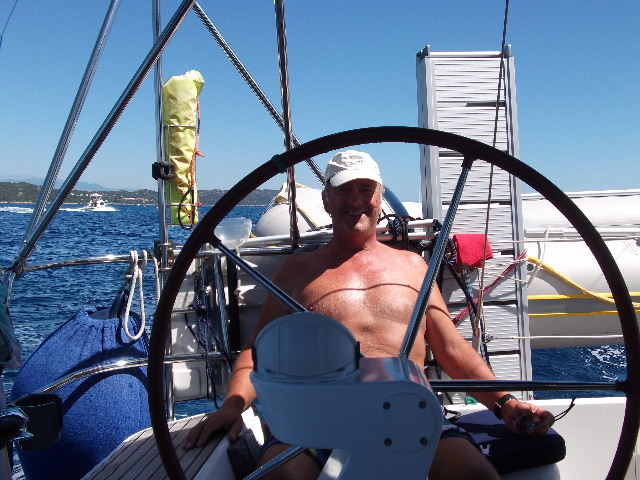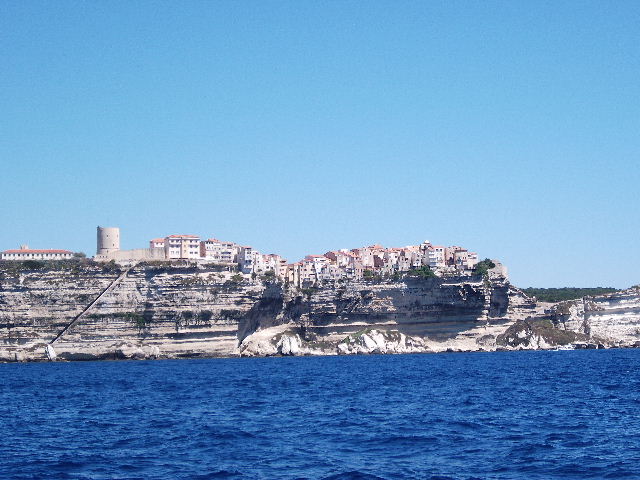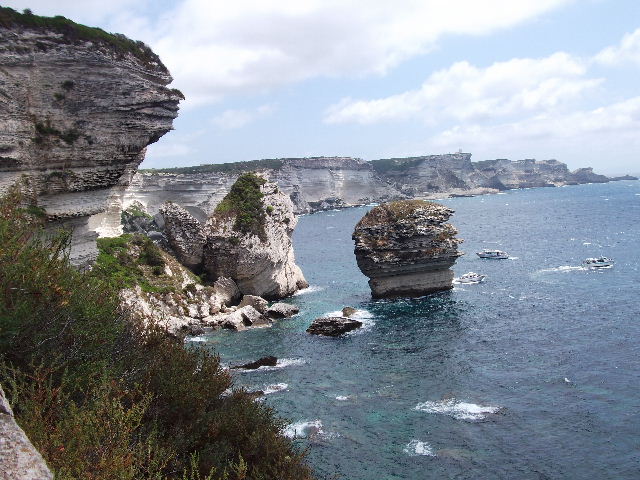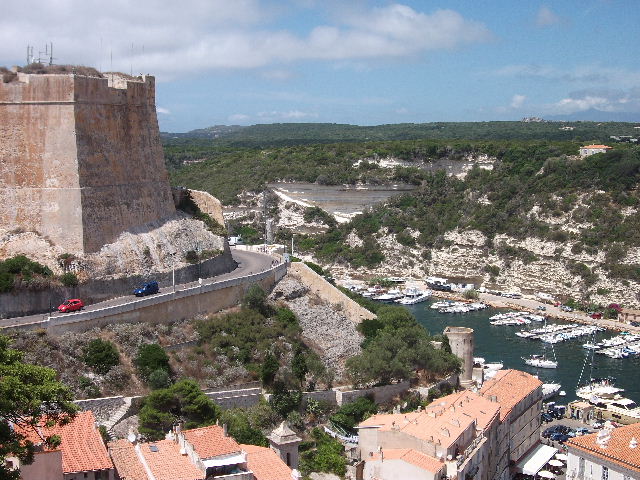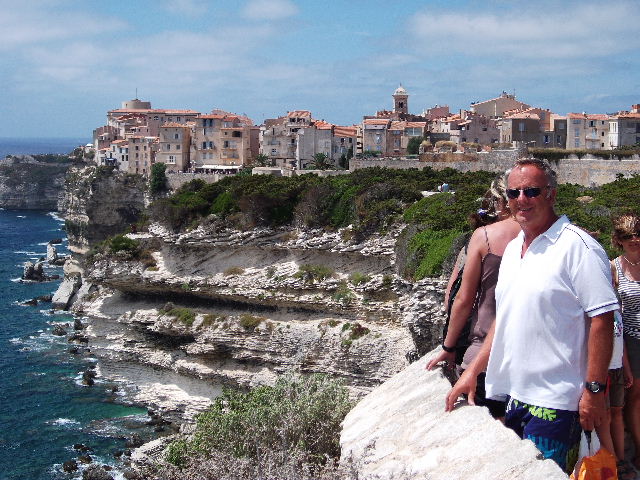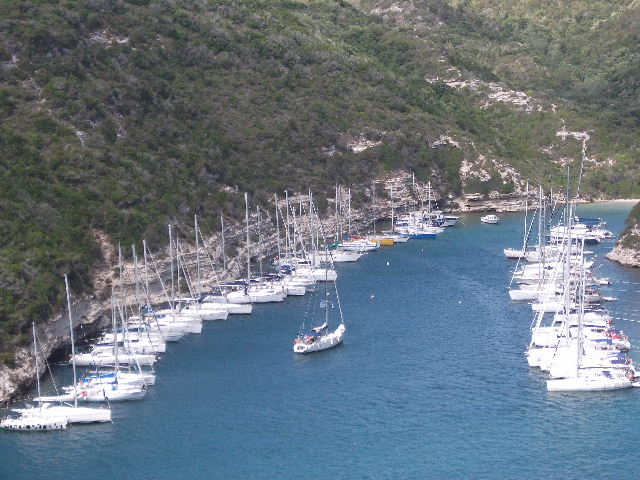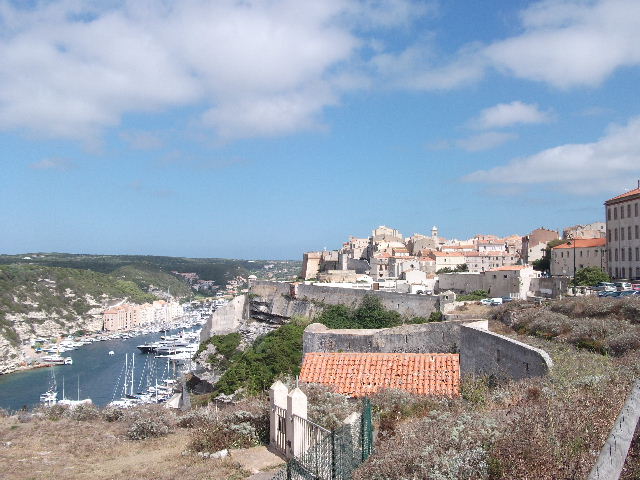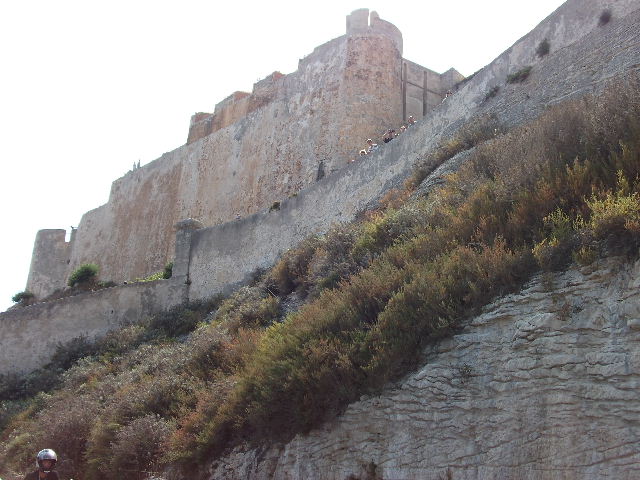41:23.45N 09:09.33E Bonifacio

41:23.45N 09:09.33E Bonifacio
We had a super motor sail for 26 miles in the early morning to Bonifacio taking in the lovely scenery at Chiappa Head, passing the Cerbicales Islands, Palombaggia, Santa Giulia, Romdinara, Sperone and the Islands of Cavallo before seeing the high cliffs of Bonifacio.
We had not been ready for the dramatic view of Bonifacio as we rounded Cap Perusato. The town of Bonifacio is perched on the edge of the limestone cliffs which have been eaten away under the old town and the outside houses are perched on a huge natural balcony over the sea itself. At the base of the cliffs are caves which have been created by the action of the sea.
Jim piloted Ariel through the entrance to the harbour which is in a calanque on the SW corner of Corsica. It is literally a slit in the chalk cliffs and very difficult to see until close up. We managed to find a space in the Calanque de la Catena with a stern to ring on the cliff with a bow line to pick up. We are now sandwiched between an English couple who like us started on their sailing journey last year from Southampton and two families on a chartered Jeanneau 45 from Bournemouth. Small world!
We had come to Bonifacio to meet up with our New Zealand friends who wintered with us in Barcelona. They went on to the Balearics in May and crossed to Sardinia and are now working their way up to the Cinque Terres before heading south again for the winter. We spent lunch and dinner together and exchanged stories of our three months sailing. John and Robyn have been sailing for the last nine summers from Fiji to here on catamarans. In the calanque there is a large chain down through the middle of it with pick up lines off of it. Every day people put their anchors down on mooring and when they wish to leave the next day or so are stuck. The marina divers are very happy as they charge 160 euros to free each one! Luckily we were advised on entering the calanque by John ‘no anchor’. Unfortunately, the wind does blow down through the calanque and every boat which comes in has problems mooring as the wind catches the side of the boat. Jim and our neighbour together with other good souls have both been busy saving people from causing damage to neighbouring boats.
Today John and Robyn left us so Jim and I made for the town to explore this very exciting citadel. Artefacts found show that Bonifacio was inhabited probably from the Neolithic period and was utilised by the Romans from 828 when Count Bonifacio returning from an expedition against the Saracens and built the first fortifications and gave it his name.
Jim and I walked up to the citadel taking in the marvellous views of the cliffs on the way. The houses are four and five storeys high and are located in narrow cobble streets with many restaurants and small shops.
As you pass through the entrance to the citadel you walk under the mechanism for lifting the drawbridge. As you can see from the photographs this castle was made for sieges. One attempt was in 1420 when the King of Aragon attacked it as Bonifacio was true to Genoa in Italy. In August 1420 Alfonso V of Aragon sailed his fleet of 80 ships into the harbour and the siege began. The Aragonese set up mortars and cannons and began to bombard the town. The Aragonese troops had muskets which was a new invention. This terrified the town’s people who had no fire arms or cannons of their own. They used bows and arrows, stones, boiling water and molten lead. For three months the citadel with stood the siege but it ran out of food and the people agreed to surrender if no help came from Genoa. 32 child hostages were given to Alfonso as a sign of good faith. Just after Xmas seven Genoese ships appeared and with the help of the townspeople broke through Alfonso’s ships and landed food. The women and boys dressed in dead men’s clothing and walked around the battlements as though there were still many townspeople to fight.
The Genoese ships broke out from the harbour and sailed back to Genoa for more supplies. Alfonso was so upset he took his ships and the child hostages on the 5th January, 1421 and sailed away never having gained control of the citadel and Bonifacio.
The countryside around is beautiful and we intend spending several days here exploring the area.
